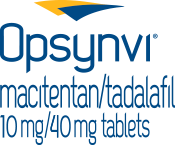
This site is intended for
U.S. healthcare professionals
2022 ESC/ERS Guidelines recommend combination therapy to address multiple pathways
The endothelin and nitric oxide pathways are 2 of the current therapeutic targets in PAH1
The 2022 ESC/ERS Guidelines recommend initial combination therapy of an ERA and a PDE5 inhibitor for patients with idiopathic PAH, heritable PAH, PAH-CTD, or drug-associated PAH without cardiopulmonary comorbidities at low or intermediate risk.1
The guidelines include a Class I, Level B recommendation for the combination of macitentan and tadalafil for newly diagnosed patients with PAH (WHO Group I) and patients at follow-up based on risk.1*
- Class I: Evidence and/or general agreement that a given treatment or procedure is beneficial, useful, effective. Level B: Data derived from a single randomized clinical trial or large non-randomized studies.
For treating adult patients with
PAH in WHO FC II-III,
OPSYNVI® (macitentan/tadalafil) is the first and only US FDA-approved single-tablet combination of 2 recommended treatments.1-3
Science Liaison (MSL)Contact your MSL
ERA=endothelin receptor antagonist; ERS=European Respiratory Society; ESC=European Society of Cardiology; FC=Functional Class; FDA=US Food and Drug Administration; PAH=pulmonary arterial hypertension; PAH-CTD=PAH associated with connective tissue disease; PDE5i=phosphodiesterase type 5 inhibitor; WHO=World Health Organization.
References: 1. Humbert M, Kovacs G, Hoeper MM, et al; ESC/ERS Scientific Document Group. 2022 ESC/ERS Guidelines for the diagnosis and treatment of pulmonary hypertension: the Task Force for the Diagnosis and Treatment of Pulmonary Hypertension of the European Society of Cardiology (ESC) and the European Respiratory Society (ERS). Eur Heart J. 2022;43(38):3618-3731. 2. OPSYNVI® (macitentan/tadalafil) full Prescribing Information. Actelion Pharmaceuticals US, Inc. 3. Grünig E, Jansa P, Fan F, et al. Randomized trial of macitentan/tadalafil single-tablet combination therapy for pulmonary arterial hypertension. J Am Coll Cardiol. 2024;83(4):473-484.